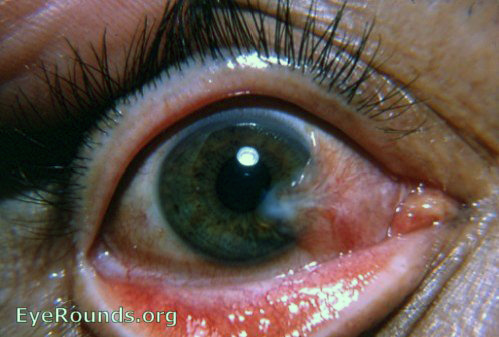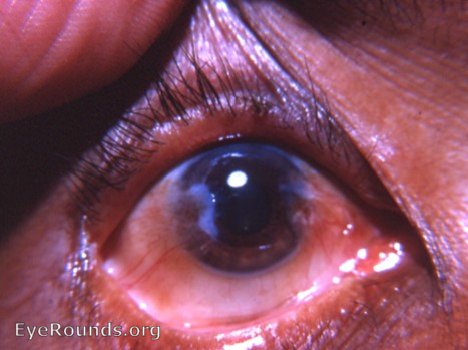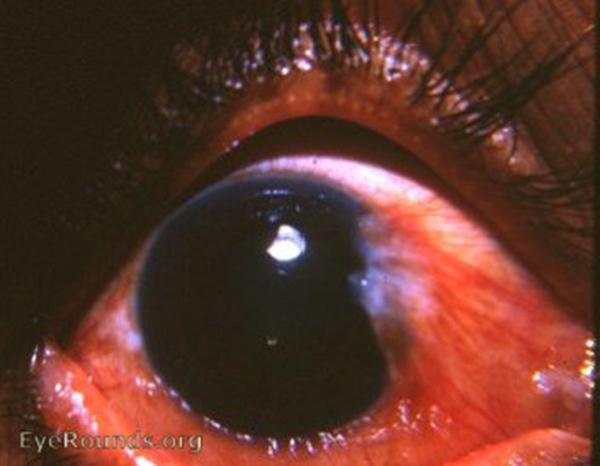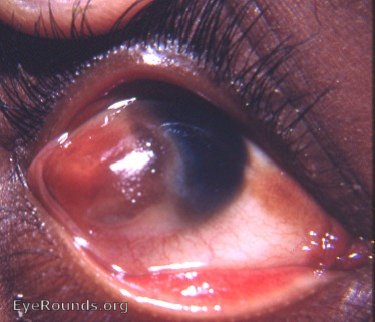EyeRounds Online Atlas of Ophthalmology
Contributor: William Charles Caccamise, Sr, MD, Retired Clinical Assistant Professor of Ophthalmology, University of Rochester School of Medicine and Dentistry
*Dr. Caccamise has very generously shared his images of patients taken while operating during the "eye season" in rural India as well as those from his private practice during the 1960's and 1970's. Many of his images are significant for their historical perspective and for techniques and conditions seen in settings in undeveloped areas.
Category: Cornea
EyeRounds Online Atlas of Ophthalmology
Contributor: William Charles Caccamise, Sr, MD, Retired Clinical Assistant Professor of Ophthalmology, University of Rochester School of Medicine and Dentistry
*Dr. Caccamise has very generously shared his images of patients taken while operating during the "eye season" in rural India as well as those from his private practice during the 1960's and 1970's. Many of his images are significant for their historical perspective and for techniques and conditions seen in settings in undeveloped areas.
Category: Cornea
Pterygium: a prototypical example

This photo demonstrates an active, well-developed nasal pterygium which is about to enter the pupillary area of the cornea.

Pterygium - temporal and nasal pterygia in an eye

The usual location for a pterygium is the nasal limbus. Occasionally an eye will demonstrate pterygia both nasally and temporally. Rarely does a pterygium occur just temporally. In the photo the eye presents with nasal and temporal pterygia. The history of the pterygium is replete with analyses of its etiology and its treatment. The pterygium has frustrated many eye surgeons. At the time of thism posting, the technique of John A. Hovanesian, MD would seem to offer encouraging results. He employs a thin autograft of superior limbic conjunctival-corneal tissue containing stem cells. The autograft is glued to the bare sclera at the site of the dissected pterygium. The glue is a fibrin glue - Tisseel.This fibrin glue obviates the use of sutures in placing the autograft. A possible role for laser in pterygium treatment is also being evaluated by others.
(added January 2018, see references 1-3 below)
Pterygium - active

The surgeon's success rate with his pterygium operations will be in direct proportion to the number of inactive pterygia in his caseload. It is the active pterygium that has the greater potential for nasty recurrence(s).
In private practice, Dr. Caccamise examined a patient who had had 7 operations for the same pterygium.
From Fuchs's Textbook of Ophthalmology: "The existence of a progressive or a stationary pterygium is determined mainly by the character of the apex of the growth. In the former : the apex appears surrounded by a gray non-vascular zone which looks thick and gelatinous. In the latter: this marginal zone is thin and cicatricial looking and the whole pterygium is thin, pale, nearly destitute of vessels, and tendinous."
Pterygium surgery - repeatedly unsuccessful surgery

The patient stated that "innumerable " surgeries had been performed on the right eye. Several operations for pterygium have been advocated over the years. Surgery on an active pterygium has a greater potentiality for recurrence.
References Regarding Pterygium Surgery
- Hovanesian JA, et al T; ASCRS Cornea Clinical Committee. Surgical techniques and adjuvants for the management of primary and recurrent pterygia. J Cataract Refract Surg. 2017 Mar;43(3):405-419. doi: 10.1016/j.jcrs.2017.03.002. PubMed PMID: 28410726.
- Shusko A, Hovanesian JA. Pterygium excision with conjunctival autograft and subconjunctival amniotic membrane as antirecurrence agents. Can J Ophthalmol. 2016 Dec;51(6):412-416. doi: 10.1016/j.jcjo.2016.02.022. Epub 2016 Sep 30. PubMed PMID: 27938950.
- Sheppard JD, Mansur A, Comstock TL, Hovanesian JA. An update on the surgical management of pterygium and the role of loteprednol etabonate ointment. Clin Ophthalmol. 2014 Jun 13;8:1105-18. doi: 10.2147/OPTH.S55259PubMed PMID: 24966664; PubMed Central PMCID: PMC4063821.

Ophthalmic Atlas Images by EyeRounds.org, The University of Iowa are licensed under a Creative Commons Attribution-NonCommercial-NoDerivs 3.0 Unported License.

Ophthalmic Atlas Images by EyeRounds.org, The University of Iowa are licensed under a Creative Commons Attribution-NonCommercial-NoDerivs 3.0 Unported License.


